|
|
|
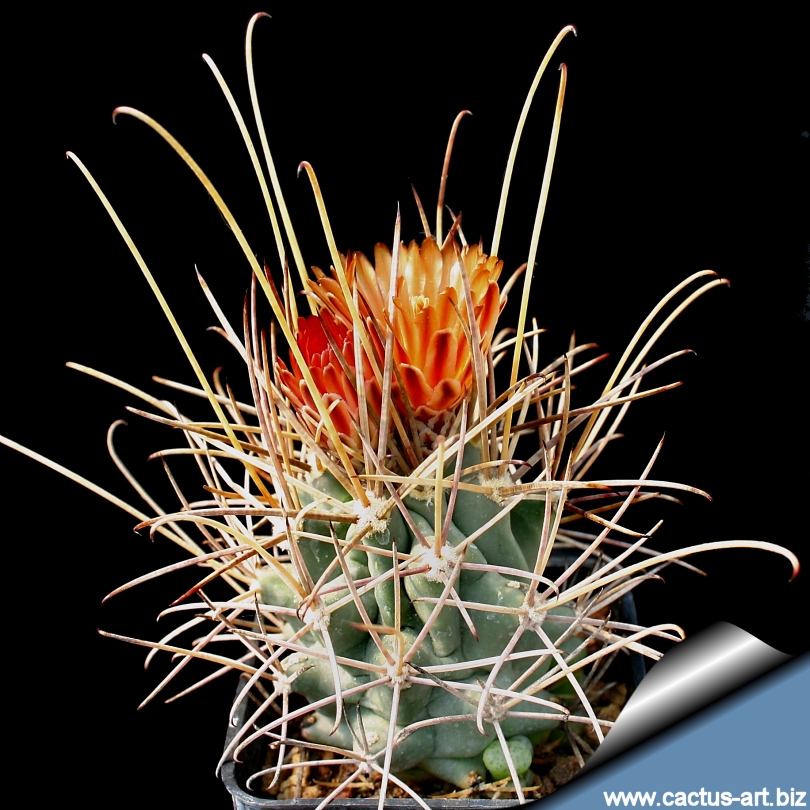
Glandulicactus
wrightii
SB840 Cuatrocienagas
Tiny blue-grey stems. Hooked coloured spines.
Frost hardy to temperatures as low as -12° C.
|
|
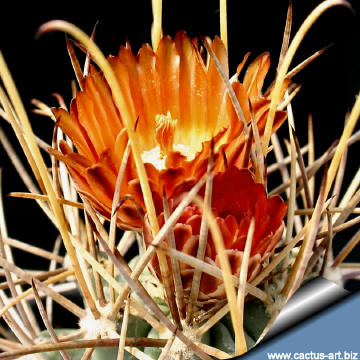
|

|
|
. |
|
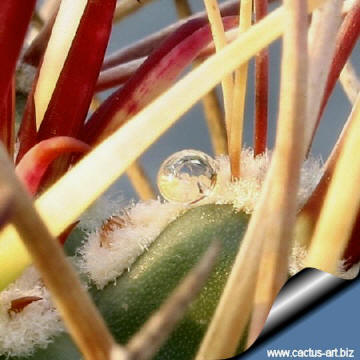
A drop of
nectar from from the
areolar
gland.
|

New spines are bright red
|
|
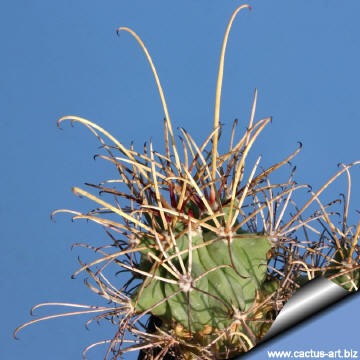
Spines are very long and hooked.
|
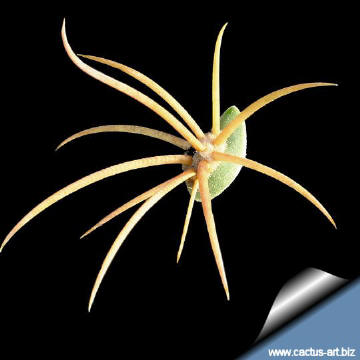
Spine cluster
|
|
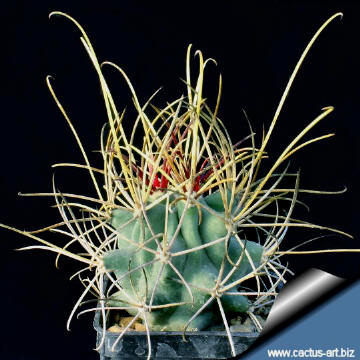 |
 |
|
Cultivation: Somewhat sensitive to overwatering (rot prone) and slow-growing.
Grow in a mineral
cactus compost and provide good
drainage.
Water in moderation, it prefer a
completely dry place during winter. An unheated greenhoouse would be perfect. It can survive low temperatures, approx.
-7° (-12°) C. They will do their best with lots of sun and become
stressed with inadequate light which could result in poor growth and
unnatural shape.
Provide very good
ventilation.
Reproduction:
Seed.
Photo of conspecific taxa, varieties, forms and
cultivars of plants belonging to the
Glandulicactus uncimnatus complex (This
Taxon
has many synonyms whit several controversial varieties and
subspecies and comprises a multitude of different forms, but where each form
is linked to others by populations of plants with intermediate
characteristics):
|
|
Advertising
|
|
|
|
|
Family:
Cactaceae (Cactus
Family)
Scientific name:
Glandulicactus wrightii
(Engelmann) D. Ferguson
Origin:
Widespread
and relatively common over a large area ranging from South-western US
(Texas, New Mexico), to Mexico (Chihuahua, Coahuila, Durango, Nuevo León,
Sonora, Zacatecas).
Habitat: Chihuahuan desert scrub,
semi-desert grasslands, limestone outcrops, sometimes igneous 500-2000 m
often growing within tuft of grass, this suggest that grasses are the
most important nurse plants for this cactus..
Conservation status: Listed in
CITES appendix
I
This plan is listed in CITES app I and treated as endangered but it is
not rare with a wide distribution in the U.S. (south-eastern New Mexico
and scattered throughout Trans-Pecos Texas)
Common English Names include:
Wright's Fishhook Cactus, Cat-claw cactus,
Turk's head, brown flowered hedgehog, mountain fishhook cactus,
eagle-claw cactus.
Etymology: The variety epithet honours the early plant
collector Charles Wright (See also:
Mammillaria wrightii)
Synonyms:
- Glandulicactus uncinatus
var. wrightii (Engelmann) Backeberg,
In:
Cactaceae. 5: 2925. 1961
- Sclerocactus
uncinatus var. wrightii
(Engelm.) N.P. Taylor
- Echinocactus wrightii J.
M. Coul.
- Sclerocactus uncinatus subsp.
wrightii (Engelm.) N. P. Taylor
In: Cactaceae Consensis
Init. 5:13. 1998
- Sclerocactus uncinatus var.
wrightii
- Echinocactus uncinatus
var. wrightii Engelmann
In: Proc. Amer. Acad. Arts 3: 272.
1856
- Ancistrocactus uncinatus
var. wrightii (Engelmann) L. D. Benson
- Echinomastus unicinatus var.
wrightii (Engelmann) F. M. Knuth
- Thelocactus uncinatus var.
wrightii,
- Pediocactus uncinatus var.
wrightii,
- Hamatocactus wrightii,
- Hamatocactus uncinatus var.
wrightii,
- Ferocactus uncinatus var.
wrightii,
- Echinomastus uncinatus var.
wrightii
|
|
Description: Medium sized
solitary cactus with very long central hooked spines .
Stem: Globose or short columnar glaucous green or greysh green in
colour, up to 15 cm tall, and not more than 8 cm in diameter.
Ribs: Protruding, 9-15 mm hight, 6-10 mm wide, deeply notched and
thus almos divide in tubercles,
Spines: New spines in young areoles are pink to reddish, later
straw coloured to pale gray.
Radial spines: 8-10 , abaxial 3 hooked , nearly as thick as
central spines 15-45 mm long.
Central spines: Hooked, 5-12 cm long.
Root: Tap root.
Flowers: Relatively small, Approx. 2-4 cm. long, 2-3 cm in
diameter. Very distinctive brick-red to purplish or brownish purple,
usually dark or dull. (Much the colour of Mammillaria pottsii flowers).
Several flowers usually develop together at the stem apex.
Blooming season: Spring (March-May), the flowers remain open for
up to twelve days.
Fruits: Roundish, bright red, with numerose conspicuous white
fringed scales, pulp mealy. Fruiting May-June. it is common to see
several fruit developing simultaneously at the stem apex.
The northern species
Glandulicactus uncinatus var. wrightii has
characteristic red fruits while the similiar and often confused
Glandulicactus uncinatus var. uncinatus has green
fruits and is endemic in and around San Luis Potosí, Mexico south of
var. wrightii; perhaps it is more similar to
G. mathssonii from even farther south (Guanajuato).
|
|
|
|

A drop of
nectar from from the
areolar glands on
the tubercles
groove.
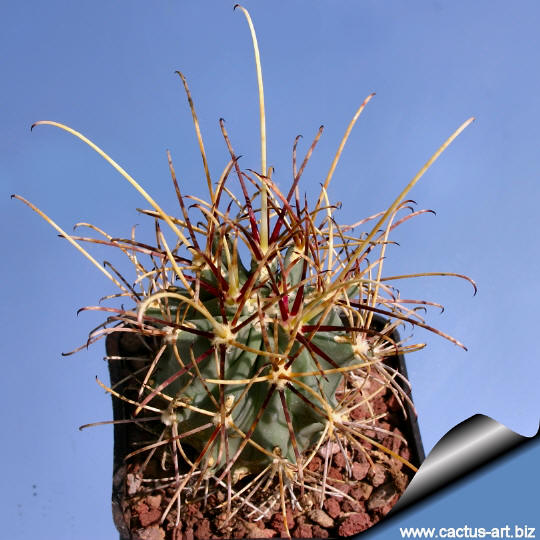
G. wrightii SB338 Otero County, New Mexico, USA
|
|


|
|